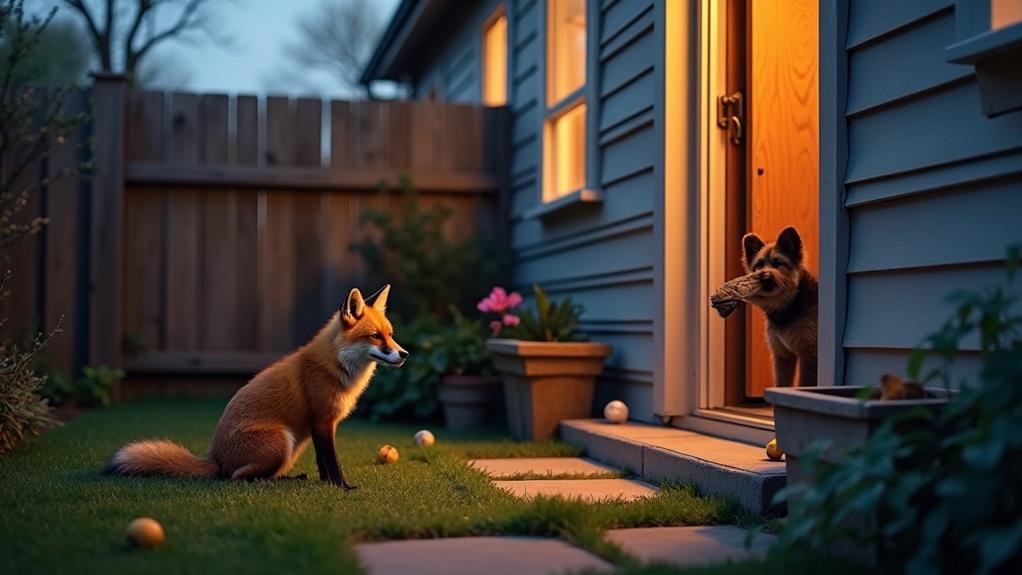Red foxes can be a bit of a concern for your pets, especially smaller ones like toy breeds. While they're not generally aggressive, they're opportunistic feeders and might see your fluffy friend as a snack, especially if they're roaming outside unsupervised. In fact, most foxes are more interested in trash than chasing pets, but you still want to keep an eye on your little buddies. Also, foxes can carry some health risks, like rabies. So, if you've got a curious cat or small dog, it's best to keep them safe and limit their outdoor time in fox-populated areas. Curious about more tips?
Contents
Understanding Fox Behavior

Understanding fox behavior is essential for pet owners who want to guarantee their pets' safety.
Red foxes are highly adaptable animals, often found in urban settings, and their presence might increase in areas where food is easily accessible urban red fox populations due to scavenging opportunities.
Foxes aren't usually dangerous, preferring to dodge trouble rather than confront it. However, when it comes to small pets like kittens or little dogs, you might want to be more cautious. Their size and vulnerability can make them tempting targets, especially if food is scarce in the foxes' natural habitat.
Foxes are opportunistic feeders, meaning they'll go after whatever's available. If you happen to have smaller pets roaming around outdoors, they could catch a fox's eye.
It's also worth noting that protective mother foxes can get feisty when defending their young. Their instinct to protect can lead to aggressive behavior if they perceive your pets as a threat.
Risks to Domestic Pets
Red foxes can pose certain risks to domestic pets, particularly smaller animals. While it's a rarity for foxes to attack adult cats—studies show just a 0.14% chance in the UK—it's wise to stay cautious.
Urban foxes have developed effective foraging techniques that allow them to scavenge more efficiently in residential areas. Foxes are dangerous to smaller dogs, especially toy breeds. If you leave them unattended outside, they could be at risk of a curious fox wanting to assert itself.
The fox family generally prefers to hunt small mammals or birds rather than confront a pet. Yet, the idea of a fox attack on your fluffy friend isn't something to ignore, especially if you also have poultry or small livestock. Securing those enclosures is essential because these animals can attract foxes looking for a meal.
To further safeguard your pets, proper waste management can make a world of difference. Keeping trash bins secure and managing pet food can prevent foxes from visiting your yard, reducing the danger to pets.
While injuries from fox encounters can happen, quick medical attention can help your pet bounce back. A bit of wildlife control can keep the peace in your neighborhood and let your pets enjoy the outdoors safely!
Safety Precautions for Pet Owners

To keep your pets safe from red foxes, it's essential to take precautions consistently. Keeping your furry friends secure not only protects them, but it also brings peace of mind to you. Here are some practical steps to take:
- Supervision: Always supervise your small pets outside, especially kittens and small dog breeds. They're more vulnerable to foxes.
- Keep Cats Indoors: It's best to keep your cats indoors. They're generally safe from foxes that way, and they can enjoy cozy indoor adventures instead of potential danger.
- Secure Enclosures: Make sure that small pets and poultry are in secure enclosures when outdoors. Foxes are smarter than they look and can find their way into your yard!
Also, monitoring pets in areas where foxes are spotted helps reduce those risky encounters.
If you do spot a red fox, don't hesitate to report it to local animal control. They're there to help manage the situation and promote safety for pets in your community.
Health Concerns Associated With Foxes
The presence of red foxes in your area brings potential health risks to your pets that every owner should be aware of. While these clever critters might charm you with their bushy tails, they can be dangerous for your furry friends. Foxes can carry rabies, which poses serious health risks to unvaccinated pets through bites or scratches. It's a good idea to keep your pets up-to-date on vaccinations to protect them from these frightening possibilities.
Additionally, red foxes are resourceful animals that often take advantage of urban environments, which increases encounters with pets in residential areas, especially in urban habitats where food sources are readily available for scavengers like them.
Moreover, foxes leave behind droppings that might harbor bacteria and parasites. If your domestic animals munch on something they shouldn't, it could lead to some nasty surprises. Don't forget about mange, a condition caused by pesky mites. It can irritate both foxes and your cozy companions, leading to costly vet visits.
And the truth is, pet encounters with foxes aren't uncommon, especially for those furry explorers left outside. While the risk of zoonotic diseases transferring to humans is low, your pets' well-being must remain a priority. If you suspect any health issues after a fox encounter, it's wise to reach out to animal control and your veterinarian for guidance.
Managing Fox Interactions in Urban Areas

Managing interactions with foxes in urban areas requires a proactive approach to keep your pets safe. Urban foxes, especially during spring, may see small pets like cats and tiny dogs as potential snacks.
Here are some straightforward steps to help with fox management:
- Secure Food Sources: Make sure your trash cans are tightly closed and avoid leaving pet food outside. If you're feeding outdoor animals, do it during the day and clean up promptly.
- Supervise Pets: Keep a close eye on your pets when they're outside, especially in areas known for fox activity. Having a buddy system can make interactions safer and more enjoyable.
- Use Deterrents: If a fox approaches too closely, don't panic! Loud noises or even tossing small objects can help scare them away. It's important to maintain a safe distance between wildlife and your furry friends.
If you notice any aggressive behavior in foxes, like foaming at the mouth, report it to local animal control.
Keeping your neighborhood safe is a community effort, and you can play a significant role in ensuring everyone's well-being!
Final Thoughts
So, while red foxes might be cute and furry, they can pose real risks to your pets. Just think about it: a small, playful dog could easily catch a fox's eye, much like a fox might catch your dog's curiosity! But don't worry—by taking a few simple precautions, you can enjoy both your pets and the wildlife around you. Stay alert, secure your yard, and embrace the beauty of nature, all while keeping your fur babies safe and sound!














